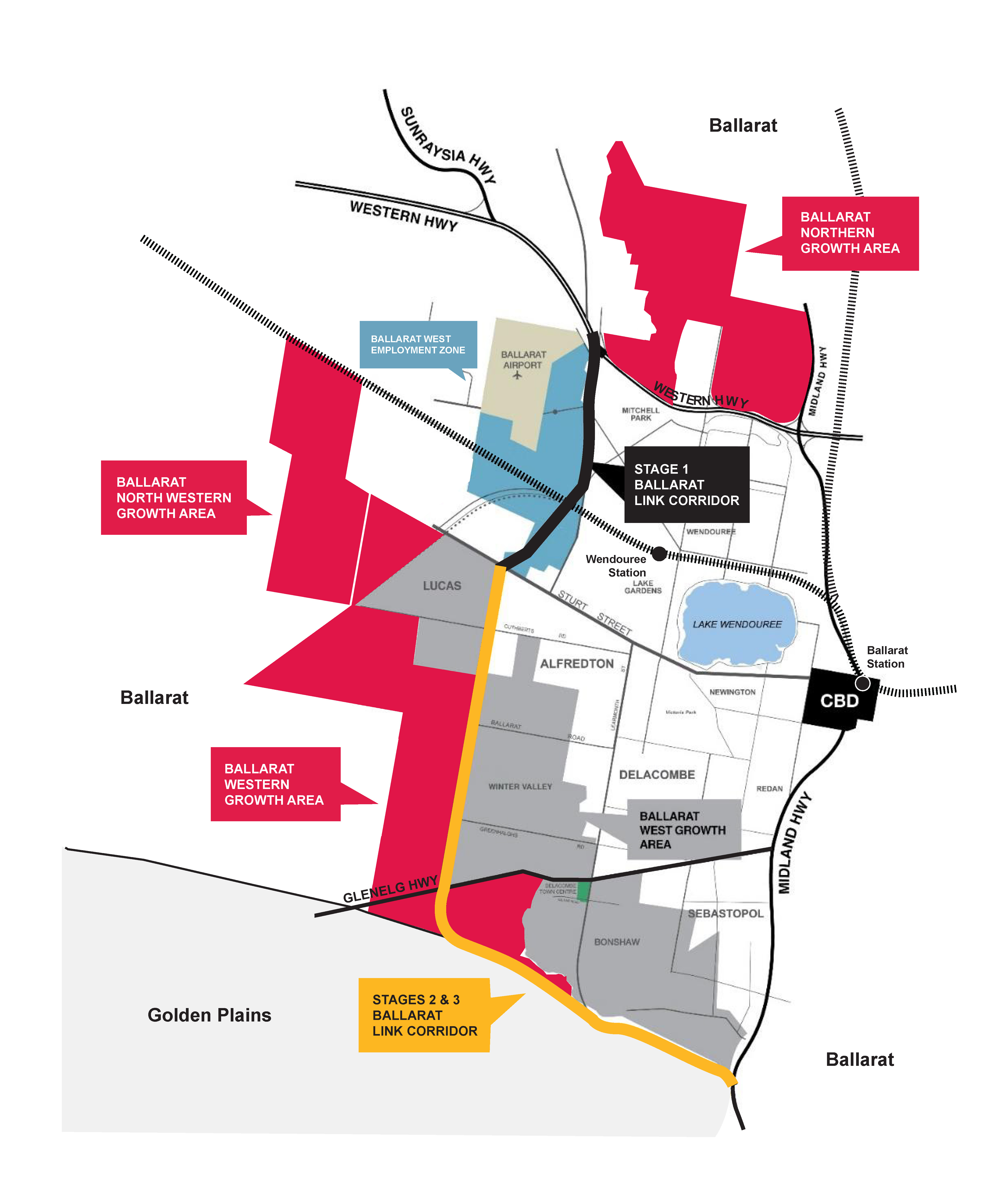Ballarat's Future Growth Areas

What are future growth areas?
Future greenfield land supply is required once land supply within the existing Ballarat West Growth Area diminishes. The areas identified as Ballarat’s future greenfield growth areas, capable of accommodating Ballarat's expected greenfield growth and housing demand beyond 2041 are:
- Western Growth Area
- Northern Growth Area
- North-Western Growth Area
Greenfield land or growth areas are former rural land areas that are identified to be developed for residential purposes. The land is typically undeveloped land and may have been previously used for agricultural or rural uses.
Strategic planning in Victoria seeks that local Council ensure 15 years of land supply is provided. Greenfield land is one element of land supply.

Western Growth Area
The Western Growth Area is expected to provide between 12,900 – 17,200 dwellings.
Key features of the area includes:
- Located in parts of Bunkers Hill, Lucas and Smythes Creek
- Broadly bound by Dyson Drive, the Kensington Creek corridor and the Ballarat West Growth Area boundary to the east. Cuthberts Road to the north, Bunkers Hill to the west and the municipal boundary/ Bells Road to the south
- Partially bound by and intersected by the Glenelg Highway
- Partially bound by the proposed Ballarat Western Link Road along its eastern boundary
View or download the Western Growth Area Map
Northern Growth Area
The Northern Growth area is expected to accommodate up to 6,000 dwellings.
Key features of the area include:
- Located in parts of Mount Rowan and Miners Rest;
- Broadly bounded by Mount Rowan/ Cummins Road to the north, the Burrumbeet Creek Corridor / Delaney Drive to the west. the Western Freeway to the south and the Midland Highway to the east; and
- Adjacent to the Ballarat North Wastewater Treatment Plant & Water Reclamation Plant on the northern side of the freeway.
The Minister for Planning has rezoned the core area of the Northern Growth Area to Urban Growth Zone.
The VPA will prepare a PSP for the Northern Growth Area and consider extending the boundary to include the ‘expanded area.’
More information on the Ballarat North PSP can be found by visting:
View or download the Northern Growth Area Map
North-Western Growth Area
The North-Western Growth area is expected to provide between 7,200 – 9,600 dwellings.
Key features of the area include:
- Irregular in shape and located to the west of Ballarat in parts of Lucas and Cardigan
- Roughly bound by the railway alignment to the north, Dowling Road/ Ballarat-Skipton Rail Trail to the east. Cuthberts Road to the south and partially bounded by Draffins Road to the west
- Broadly divided into two halves its middle by Remembrance Drive
- Land to the south of Remembrance Drive is located adjacent to the Lucas Estate Alfredton West Precinct (i.e. east side of Ballarat-Skipton Rail Trail)
- Land to the north of Remembrance Drive is located adjacent to an existing Rural Living Zone (RLZ) land
View or download the North-Western Growth Area Map
Status of the Future Growth Areas
On 23 February 2022, Council resolved to seek Ministerial authorisation to:
- Rezone the three future growth areas as Urban Growth Zone (UGZ)
- Commence preparation of a Precinct Structure Plan for the Northern Growth Area
- Commence preparation a Growth Areas Framework Plan to establish the most appropriate sequencing of Precinct Structure Plan preparation for the Western and North Western growth areas.
The City of Ballarat has prepared a Growth Areas Framework Plan for the Western and North Western Growth areas to inform appropriate staging and sequencing of residential growth. The document was adopted by Council in August 2024. Updates on this project can be found on the City of Ballarat MySay Page.
In August 2022, the Minister for Planning requested that the Victorian Planning Authority (VPA) prepare a high-level strategic review of Ballarat’s greenfield land and infill areas to inform future staging of residential growth and ensure adequate land supply. The VPA will prepare a review of Ballarat’s greenfield and infill land supply in the form of an Infrastructure Growth Alignment Framework (IGAF). Updates on this project can be found on the VPA’s IGAF webpage.
Contact the Sustainable Growth Team
For any questions about the Ballarat Growth Areas:
- Email: growthareas@ballarat.vic.gov.au
- Phone: City of Ballarat Customer Service on 5320 5500 and ask for the Sustainable Growth Team